3 marketing campaigns that deserved a standing ovation in July 2025
Some ad campaigns completely redefine how we think about creativity, media, and brand confidence.
We’ve picked out three recent examples that stood out for their originality and ability to cut through the noise (which is increasingly hard to do these days).
Canva’s billboards: product features as real-world creative moments
What they did: As part of a high-impact outdoor campaign, Canva took over London Waterloo with a series of billboards that each highlighted a different creative tool, brought to life in unexpected and often hilarious ways.
Some standout examples:
Background removed using Canva: a ‘transparent’ billboard, showcasing Canva’s background removal tool by using it on the ad itself.
Magic Resize in action: a landscape ad awkwardly compressed into a portrait space, riffing on the usefulness of Canva’s automatic resizing feature
Make the logo bigger: an exaggerated, oversized Canva logo breaking out of its frame, poking fun at a cliché client request that’s all-too familiar to any graphic designer
Post-Its galore: a billboard overflowing with Post-It notes, nodding to Canva’s collaborative features
Why it works: this campaign went beyond just listing features—it brought them to life. Each billboard turned a digital tool into a real-world metaphor that anyone in marketing, design, or content could instantly relate to. The copy was cheeky, the visuals punchy, and the concept walked that line between clever and self-aware without tipping into gimmick.
How to apply it: you don’t need to explain your product. If your tool fixes something annoying, start with the pain point! Show that moment of frustration, then land the payoff in a way that’s memorable, clever, and easily-discernible.
Examples you could use:
A cool idea for a SaaS email platform could be: a two-part billboard that mimics how subject lines get cut off in inbox previews. The first board reads: “Don’t miss this once-in-a—” and the second board, placed a few steps later, completes the sentence: “—lifetime offer. Preview before you send.”
It’s a playful, real-world way to spotlight the platform’s subject line preview tool, turning an everyday frustration into a memorable visual hook.
ASOS played with the Instagram format
What they did: fashion retailer ASOS shared a Reel that looked like two separate Instagram posts were interacting with each other, catching viewers off-guard!
Why it works: the ads were visually unexpected and rewarded attention. In a fast-scrolling environment, content that surprises has a better chance of getting noticed and shared.
How to apply it: thinking ‘outside the box’ has never been more literal! Maybe the Canva billboard had a point with the landscape media stuffed inside a vertical format…
Examples you could use:
If, for instance, you run an online bookstore, the first ‘post’ (remember: we’re faking two posts inside a single vertical video here) introduces a fictional character (“meet your next book boyfriend”) followed by a second ‘post’ revealing the book.
Or, another SaaS example, for AI software this time: the first post shows a clock tallying the hours spent on a manual task, and the other reveals how much time was saved by using AI.
KitKat updated a classic message with a dash of the modern
What they did: KitKat reimagined their iconic “Have a Break” slogan by swapping smartphones for chocolate bars in its visuals — a subtle (but powerful) reminder to step away from our screens and enjoy life’s simple pleasures!
Why it works: it’s a simple, timely message based on an incredibly well-known tagline. The phrasing hasn’t changed, but the meaning has.
How to apply it: if your brand has heritage, look at how your message can evolve without losing its core. Relevance is often about context, not reinvention.
Examples you could use:
A rentable fashion brand might swap the typical “Shop Now” button on their ads with a “Pause, Reflect, Rent” CTA, framing their service as a counter to the current pace of fast fashion.
Or, for a restaurant: “Connection doesn’t always need Wi-Fi,” depicting someone being unable to connect to the WiFi, and instead putting their phone down to enjoy the moment with their friends in a restaurant.
Canva, ASOS, and KitKat didn’t rely on noise or gimmicks. They respected their audiences’ intelligence, used platforms with purpose, and delivered brand messages with precision and creativity.
You don’t need a huge budget to think boldly. What you do need is the confidence and willingness to do things a little differently.




